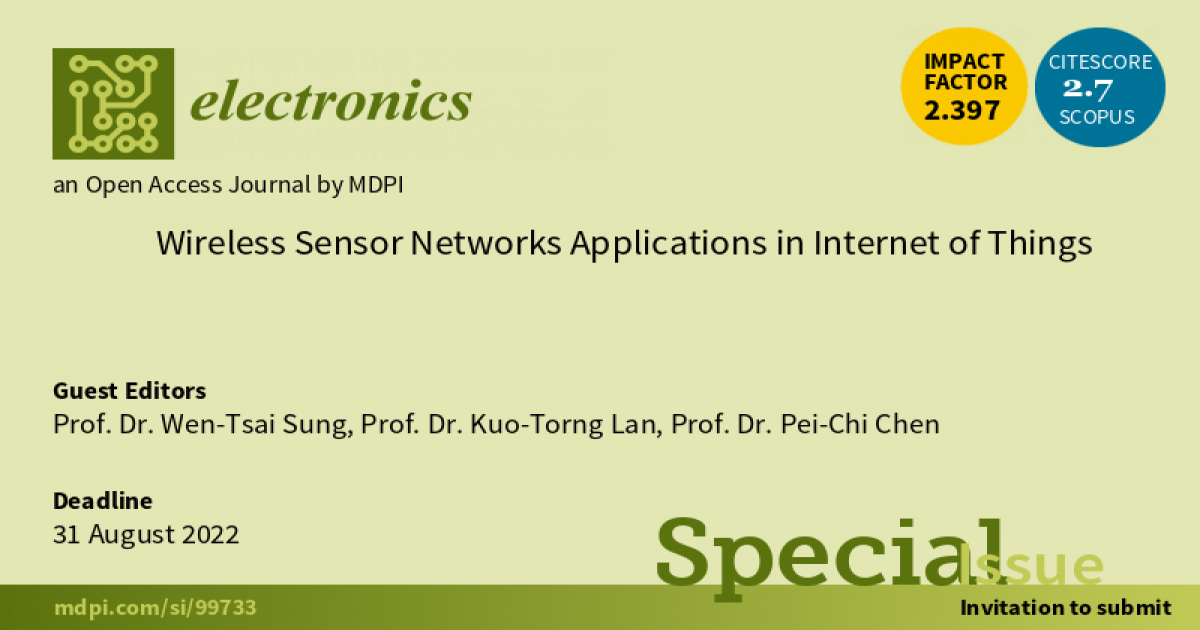Wireless Sensor Networks Applications in Internet of Things
A special issue of Electronics (ISSN 2079-9292). This special issue belongs to the section "Microwave and Wireless Communications".
Deadline for manuscript submissions: closed (31 August 2022) | Viewed by 8467

Special Issue Editors
Interests: AIoT; wireless sensor network; SOC and microcontroller design; RFID; complex curve and curved surface design
Special Issues, Collections and Topics in MDPI journals
Interests: wireless sensor network; research on application of XML/SOAP cross-platform network information exchange technology; AIoT; blockchain; fuzzy logic
Special Issue Information
Dear Colleagues,
Recent research has focused on the need to integrate artificial intelligence, machine learning, blockchain, network security, data analysis, big data, the Internet of Things, and other fast-developing fields to predict methods and technologies to provide real-time solutions to certain problems. Smart systems are not only able to increase productivity and efficiency, but they can also deal with unpredictable and imprecise issues such as variability, downtime, and human factors. Blockchain provides a decentralized, distributed, reliable technique for processing and authenticating transactions. Soft computing methods use a combination of heuristics, approximate models, and random and non-deterministic algorithm behaviors to solve the inaccuracy and inaccuracy that often exist in complex manufacturing systems through certainty and partial truth.
This Special Issue of Electronics will focus on the application of soft computing methods in intelligent automation systems, as well as attempts to enhance protection and privacy with complete communication and delivery as blockchain and AI technologies are allowed beyond 5G (B5G). The research emphasis is on incorporating and unifying technologies to produce new and smart networking services and applications as both blockchain and AI advance further.
Prof. Dr. Wen-Tsai Sung
Prof. Dr. Kuo-Torng Lan
Prof. Dr. Pei-Chi Chen
Guest Editors
Manuscript Submission Information
Manuscripts should be submitted online at www.mdpi.com by registering and logging in to this website. Once you are registered, click here to go to the submission form. Manuscripts can be submitted until the deadline. All submissions that pass pre-check are peer-reviewed. Accepted papers will be published continuously in the journal (as soon as accepted) and will be listed together on the special issue website. Research articles, review articles as well as short communications are invited. For planned papers, a title and short abstract (about 100 words) can be sent to the Editorial Office for announcement on this website.
Submitted manuscripts should not have been published previously, nor be under consideration for publication elsewhere (except conference proceedings papers). All manuscripts are thoroughly refereed through a single-blind peer-review process. A guide for authors and other relevant information for submission of manuscripts is available on the Instructions for Authors page. Electronics is an international peer-reviewed open access semimonthly journal published by MDPI.
Please visit the Instructions for Authors page before submitting a manuscript. The Article Processing Charge (APC) for publication in this open access journal is 2400 CHF (Swiss Francs). Submitted papers should be well formatted and use good English. Authors may use MDPI's English editing service prior to publication or during author revisions.
Keywords
- artificial intelligence
- big data
- blockchain
- cloud computing
- wireless sensor network
- deep learning
- fuzzy logics
- internet of things
- machine learning
- 5G







